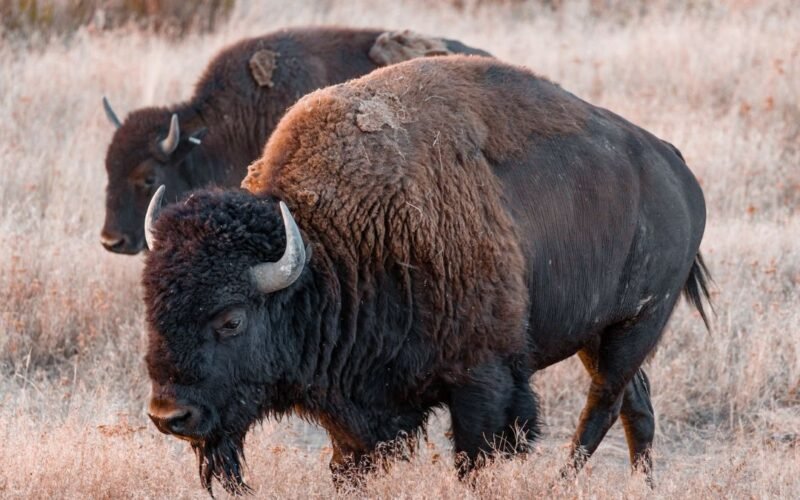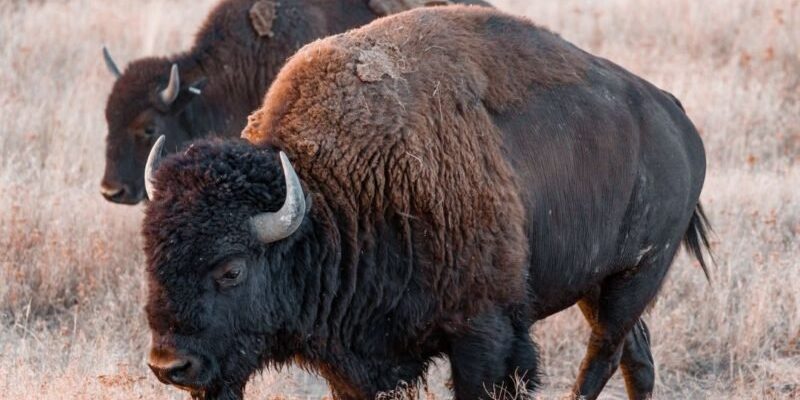
So, why should you care about these magnificent beasts? Well, the American bison isn’t just a pretty face; it has fascinating behaviors, incredible resilience, and a unique role in Native American culture. Let’s dive in and uncover some of the most interesting facts about the American bison that might just surprise you.
1. A Symbol of American History
When you think of the American bison, you might think of cowboys and Native American history. These stunning creatures have been a part of America’s landscape for thousands of years. The bison was central to the lives of many Indigenous peoples, providing not only food but also materials for clothing, shelter, and tools.
Imagine a vast plains landscape filled with these massive beasts. They symbolize the frontier spirit and are often depicted in art and literature. The bison has even been designated as the national mammal of the United States. This recognition reflects its importance in American history and culture.
2. They’re Huge—Like, Really Huge
The American bison is one of the largest land mammals in North America. Adult males can weigh up to 2,000 pounds and stand over 6 feet tall at the shoulder. That’s like having a small car roaming around! Their sheer size can be intimidating, but here’s the thing: despite their bulk, bison are surprisingly fast. They can run up to 35 miles per hour, which is faster than the average human can sprint.
If you ever get a chance to see one in person, you’ll be struck by how powerful they look. Their muscles are built for endurance as they travel great distances across the plains. Plus, their massive heads are equipped with strong horns, which they use for battling during mating season.
3. Bison Have an Impressive Diet
These herbivores are primarily grazers, munching on grasses, herbs, and shrubs. They play a vital role in shaping the prairie ecosystem by grazing, which helps maintain the health of the grasslands. Imagine them as nature’s lawnmowers, keeping the landscape manageable and diverse.
Interestingly, bison have a unique way of digesting their food. They have a complex stomach structure that allows them to break down tough plant material efficiently. This means they can thrive in environments that might not support other animals. So, when you think about it, they’re perfectly adapted to their surroundings.
4. Social Animals with a Strong Hierarchy
Bison aren’t just solitary animals; they live in social groups called herds. These herds are usually made up of females and their young, with males either remaining in the herd or roving to find a place among other males.
Within these herds, there’s a clear social structure. Older females tend to lead, guiding the herd to food and water sources. This hierarchy helps maintain order and ensures that the herd can survive in their often harsh environments. Watching how they interact is like seeing a community in action—it’s fascinating to observe their behaviors and relationships.
5. Surprising Resilience to Weather
Bison are incredibly resilient creatures. They can withstand extreme weather conditions, from the scorching heat of summer to the brutal cold of winter. When temperatures drop, a thick layer of fur grows to insulate them, making them feel warm even in freezing temperatures.
These animals are also well-suited for the winter months; their stocky legs and massive heads allow them to push through snow to find food. Imagine plowing through a snowstorm looking for dinner—that’s the bison, showing their determination every step of the way.
6. Their Role in Ecosystems
The bison is often called a “keystone species.” This means they have a significant impact on their environment. As they graze, they help maintain the health of grasslands by preventing overgrowth, which creates habitats for other species.
When bison roam, they also trample the ground, creating spaces for new plants to grow. This activity encourages plant diversity, which benefits the entire ecosystem. Their droppings help fertilize the soil, ensuring that fresh life can flourish. So, next time you spot a bison, remember they’re doing much more than just eating—they’re shaping their habitat!
7. Conservation Success Stories
Once on the brink of extinction, the American bison has made an impressive comeback thanks to conservation efforts. In the late 19th century, their population plummeted to just a few hundred due to overhunting and habitat loss. However, dedicated individuals and organizations stepped in to reverse this trend.
Today, there are over 500,000 bison in North America, with many living in protected areas and reserves. Groups have also been reintroducing bison to their historical ranges, which is a testament to the power of conservation. While they are still facing threats, progress is being made to ensure these magnificent beasts thrive for future generations.
8. They Communicate in Unique Ways
Bison have a rich vocabulary that includes grunts, snorts, and even body language. They communicate with each other to maintain herd dynamics and warn one another of potential dangers.
This communication is vital for their survival, especially when it comes to interacting with predators. Scientists have observed them forming protective circles around the young or weak members of the herd. It’s like a family meeting where everyone looks out for each other, showcasing their strong social bonds.
9. Cultural Significance
Bison carry a deep cultural significance for many Native American tribes. They are often seen as a symbol of strength and resilience. For numerous tribes, the bison represents sustenance, spirituality, and the connection to the land.
Ceremonies and rituals often include the bison, highlighting its importance in their heritage. It’s not just an animal; it’s a vital part of their identity and history, reminding us of the interconnectedness of nature and culture.
10. The Bison’s Place in Today’s World
In modern times, bison are not only admired for their beauty but also for their ecological role and contributions to sustainable agriculture. Bison ranching is becoming more popular because it’s eco-friendly; bison graze in a way that promotes healthy grasslands without the use of harmful chemicals.
Plus, with the rise of interest in local and sustainable food sources, bison meat is gaining popularity. It’s leaner than beef and packed with nutrients, providing a healthier alternative. So, whether you’re admiring them in the wild or enjoying a bison burger, these majestic creatures are making their mark in today’s world.
As you can see, the American bison is more than just an iconic figure in American history; it’s a fascinating and complex creature that plays a vital role in our ecosystems and cultures. From their impressive size to their remarkable resilience, bison embody a unique spirit of the American landscape. Let’s continue to appreciate and protect these incredible animals for generations to come!

